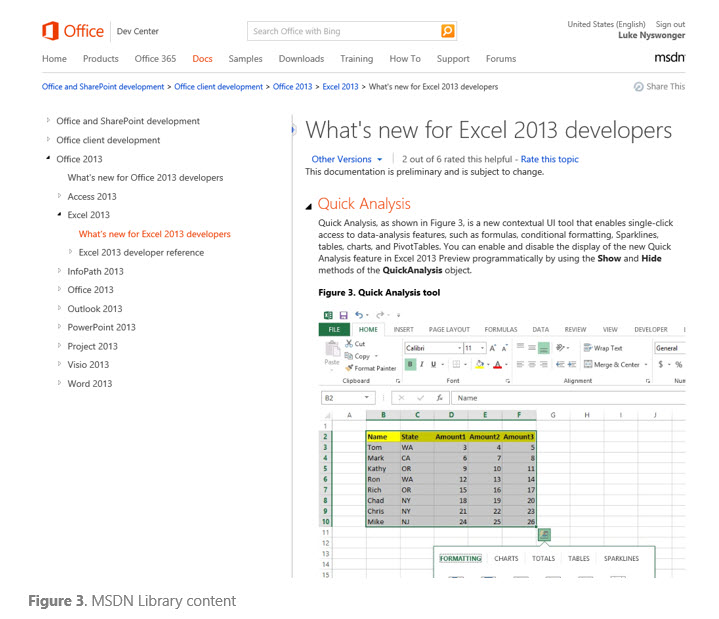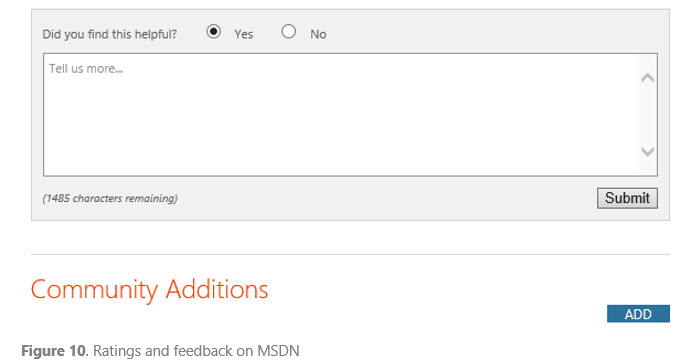Office 2013 Developer Content Landscape
Hi, my name is Luke Nyswonger and I lead the developer content team for Office programmability. My team creates developer docs, code samples, and videos for client extensibility—apps for Office, VBA, Open XML, etc. In this version of Office, we made a much larger investment for developers than any other previous releases. As both Brian and Rolando discussed in their posts, our new Office cloud app model complements our existing extensibility model and provides you more choices. Today I’m going to provide an overview of our content landscape, changes we made to the overall experience, our F1 Help story, some pointers to get you started and ways to provide feedback to the team.
Less is definitely more
One goal for this release was to ensure that the user experience on the web was optimized. To that end, we reduced noise in the system and refreshed our content with a modern approach. In short, we not only spent time writing, but also optimized the entire experience so content is discoverable and usable. You can ask my team how tired they were of hearing my mantra “More code, more pics, less text.”
Why make such a change? Here are a few fun facts that helped influence our decision:
- Tons of content. There are nearly 900,000 pieces of developer-related content assets in 11 locales that need to be managed and groomed from release to release.
- Customer satisfaction. In customer surveys, satisfaction scores indicate that discoverability is a major pain point. In fact, only 54% of developers actually find what they are looking for when searching Office developer content.
- Search. Significantly more traffic comes from search, not context-sensitive (F1) Help calls. Most page views are actually links from other Microsoft properties.
We had to embrace the fact that people are consuming information in different ways, on different devices and therefore the style and depth at which we wrote content needed to change. For this release we’ve taken two measurable approaches:
- Reduce the footprint. Retiring legacy and non-performing pages, consolidating content. Reduce clutter so you can more-easily find what you are looking for.
- Create the right content and make it modern. Skimming instead of reading is a fact on the web. In this release, we’ve optimized content to be more “glanceable” and to provide quick access to the information you need.
Farewell “wall of links”
Writers love to write. We also love to create those dreaded “walls of links”.
We’ve reduced the number of pages that consist solely of links and redesigned our remaining navigation pages to be easier to skim and use to find the information you need. As an example, we reduced the number of navigation pages from 432 to 100 (-77%).
Is that the MSDN Library?
In addition to the redesign of the developer centers, we also overhauled our content model for the library so that it was easier to navigate and use. You’ll notice our new approach to modern content and the use of everyday language. The following screenshot, from the article What’s New for Excel 2013 developers, is a good example of where we are headed with our approach to modern content.
On the left side of this page, you’ll see a new table-of-contents experience. We call this a “scoped view” of the MSDN library. We wanted to mirror this experience with all our navigational pages so the Office developer experience had a consistent look and feel. Take a look at these two examples to understand the difference:
- Non-scoped View (Lightweight, Classic, or ScriptFree)
- Scoped View
Jakob Nielsen has a famous quote in his book on web usability, “Ultimately, users visit your web site for the content. Everything else is just the backdrop. The design is there to allow people access to the content.” Eloquently put, Jakob! Through our design changes, content layout and approach to how we author the content, we hope that you are finding what you need and that the content and scenarios we are documenting are serving your needs. If not, let us know!
Enough about docs, what about code samples!?
If there is one thing we know, developers love code! It’s consistently the number one request from customers. In this release, we are building more code samples (solutions, examples, and snippets) across the content space.
Get samples online. In MSDN Code Gallery, you can discover new code samples, share your own samples, and request new samples. We have a section dedicated entirely to Office as well as Apps for Office and have begun stocking the shelves to help you accelerate stocking the Office Store!
See samples from within Visual Studio. If you’re using Visual Studio for development, there’s a great new feature available in Visual Studio 2012 that allows you browse samples from the MSDN Code Gallery and download them directly into your environment.
View examples inline with the docs. As always, we’ll continue to provide code examples and snippets within the documentation itself so you can copy/paste until your heart is content.
Who moved my cheese?
In previous versions of our developer documentation, we provided the ability to browse and read documentation offline. Pressing F1 from within the Visual Basic Editor (VBE) could be configured to route directly to the offline content with no need to be connected to the Internet. In addition, you could search and browse the offline content. This comes in handy when you’re bored on the beach and need to find out exactly what’s new for developers in Office 2013. Within the walls of Microsoft, we often refer to this experience as the “airplane scenario.” Investing in this experience has been a perennial debate across the company within every major division and for every product for the past decade.
In Office 2013, we have made some significant architectural changes for the documentation across the product line—this includes end-user Help. Here you can see the differences in the user experience with the 2010 and 2013 Help clients.
As part of the change, we also made the decision that all developer related content would be hosted on MSDN and that F1 calls from VBE would be routed to MSDN. This comes with several advantages – one canonical source of documentation, deep integration with other content on MSDN, in-sync with localized content, rapid bug fixes, always up to date, etc. However, it does have one drawback…yep you guessed it; we don’t support the “airplane scenario” out of the box. That is, when you install Office 2013 and the developer tools, there is no option to install local developer help.
But wait, hold the lemons! For all you coders on an airplane, submarine or behind the firewall, we are now offering a stand-alone version of the documentation that you can download from the Microsoft Download Center. One thing you need to be aware of is that the F1 experience is an online-only experience so even though you have the offline documentation all of your F1 help calls will route to MSDN. The download package contains offline CHM versions of the following Office 2013 client VBA references:
- Access
- Excel
- Office Shared
- OneNote
- Outlook
- PowerPoint
- Publisher
- Word
- Visio
For some client applications, the downloadable compiled Help (CHM) file includes other references besides the VBA developer reference. For example, the Visio ShapeSheet reference is included in the Visio download, and the Outlook Auxiliary Reference and the Outlook MAPI Reference are included in the Outlook download.
Speaking of feedback…
Since the first release of the developer documentation at the Customer Preview in July, we have been steadily providing updates, fixes, and new code samples for the documentation. Much of what we update is based on feedback from you. So keep it coming!
Great, so how do you provide feedback?
There are three main ways to provide us feedback on the developer content:
- Send us a comment on the topic/article. On every article on MSDN we have a feedback and ratings tool. We review every single piece of feedback that comes in and triage it for upcoming content releases. This is done via our “double-blind” system so the feedback that you provide is anonymous.
- Engage us in the community. Another way to give us feedback is to engage us in the community at the support forums, on Facebook and Twitter. Heck, we’re even on Stack Overflow!
- Send mail directly to the team. Yes, that’s right! If you feel like you want to reach out with a personal mail please send it directly to docthis@microsoft.com and we’ll review and respond.
Hello, "wall of links"
I couldn’t help myself. So while I have your attention, I’m going to showcase a few of the key resources the team has been working on which should be of tremendous value as you start building solutions for the next version of Office.
Apps for Office
- Apps for Office and SharePoint Developer Center
- Apps for Office Overview
- Create your first app
- Code Samples
- Training
General Office Development
- What’s New in Office 2013 for Developers
- Office developer product map
- Office Developer Center
- Code Samples for Office
- Office 2013 Training
Learning Centers - Office Clients
Conclusion
We are excited about this new release of Office for developers. We’ve packed MSDN with all kinds of goodies to help jumpstart your development and we have much more to come for RTM and beyond. If you have thoughts, suggestions or requests, we definitely want to hear them. With over a billion users and one copy of Office sold every second, the potential market opportunity as a developer couldn’t be any better.
Happy coding!







